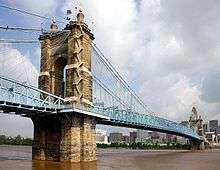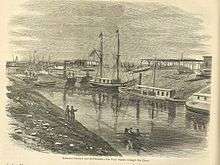1867 in science
The year 1867 in science and technology involved many significant events, listed below.
| |||
|---|---|---|---|
|
Events
- April – First clear recorded use of the word science in English with today's usage as restricted to the natural and physical sciences (by Catholic theologian and mathematician W. G. Ward writing in the London-published Dublin Review).[1]
Botany
- Gorse naturalises in New Zealand and soon becomes the worst invasive weed.
- Swiss botanist Simon Schwendener proposes his dual theory of lichens.[2]
- Rosa 'La France', the first hybrid tea rose, is cultivated by Jean-Baptiste Guillot.[3][4]
- The Big Trees Ranch at Felton, California, is bought by San Francisco businessman Joseph Warren Welch to preserve the giant redwoods (Sequoia sempervirens) from logging.[5]
Chemistry
- Alfred Nobel patents dynamite (in the United Kingdom on May 7, and in Sweden on October 19).[6][7]
- Henry Enfield Roscoe isolates vanadium.[8]
- Charles-Adolphe Wurtz synthesizes neurine.
Economics
- Publication of the first volume of Das Kapital by Karl Marx.

January 1: Roebling Suspension Bridge is longest.

February 17: Suez Canal in use.
Geology
- At Fountain Point, Michigan, an artesian water spring begins to gush continuously.
- Geological Exploration of the Fortieth Parallel established in the United States under the directorship of Clarence King.
History of science
- Assyriologist George Smith discovers an inscription recording a solar eclipse in the month of Sivan on British Museum Tablet K51, which he is able to link to 15 June 763 BC, the cornerstone of ancient Near Eastern chronology.[9]
Mathematics
- English mathematician Rev. William Allen Whitworth publishes the first edition of his Choice and Chance: An Elementary Treatise on Permutations, Combinations, and Probability.
Physiology and medicine
- March 16 – First publication of an article by Joseph Lister outlining the discovery of antiseptic surgery, in The Lancet.
- July 17 – In Boston, Massachusetts, the Harvard School of Dental Medicine is established as the first dental school in the United States.
- Henry Maudsley publishes The Physiology and Pathology of Mind.
- Viennese psychiatrist Theodor Meynert observes variations in the cytoarchitecture of the brain.
- Yellow fever kills 3093 in New Orleans.
Technology
- January 1 – The Covington–Cincinnati Suspension Bridge opens between Cincinnati, Ohio and Covington, Kentucky, its 1,057-foot (322 m) main span making it the longest single-span bridge in the world by a margin of 14 m at this time. It will be renamed after its designer, John A. Roebling, in 1983.
- February 17 – The first ship passes through the Suez Canal.
- July 2 – First elevated railroad in the United States begins service in New York.
- December 14 – Spanish inventor Narcís Monturiol submerges his submarine Ictineo II at Barcelona, demonstrating its chemically-fired anaerobic steam propulsion system.[10]
- Pierre Michaux invents the front wheel-driven velocipede, the first mass-produced bicycle.
Awards
- Copley Medal: Karl Ernst von Baer[11]
- Wollaston Medal: George Poulett Scrope
Births
- January 11 – Edward B. Titchener (died 1927), English-born structuralist psychologist.
- January 22 – Gisela Januszewska (died 1943 in Theresienstadt concentration camp), Moravian-born public health physician.
- April 16 – Wilbur Wright (died 1912), American pioneer aviator.
- June 11 – Charles Fabry (died 1945), French optical physicist.
- July 8 – Edgar Buckingham (died 1940), American physicist.
- October 21 – Aldred Scott Warthin (died 1931), American cancer geneticist.
- November 7 – Maria Skłodowska, later Marie Curie (died 1934), Polish-born physicist.[12]
- November 26 – Emil von Dungern (died 1961), German serologist.
- December 1 – Ignacy Mościcki (died 1946), chemist and President of Poland.
- December 26 – John Bradfield (died 1943), Australian civil engineer.
Deaths
- January 16 – William Marsden (born 1796), English surgeon.
- February 9 – Filippo de Filippi (born 1814), Italian zoologist.
- March 27 – Prideaux John Selby (born 1788), English ornithologist.
- May 29 – Margaretta Morris (born 1797), American entomologist.
- August 25 – Michael Faraday (born 1791), English chemist and physicist.
gollark: You don't really need to split evenly for science packs because the labs will fill up and it'll balance itself out anyway.
gollark: There are actual splitters you could unlock, but the inserters will work for now™.
gollark: You can, although it won't split evenly.
gollark: Also inserters, but those are slower and do not split evenly.
gollark: Splitters?
References
- "science, n." Oxford English Dictionary online version. Oxford University Press. September 2011. Retrieved 2011-10-31. (subscription or UK public library membership required)
- Honegger, R. (2000). "Simon Schwender (1829–1919) and the dual hypothesis in lichens". Bryologist. 103 (2): 307–13. doi:10.1639/0007-2745(2000)103[0307:SSATDH]2.0.CO;2. ISSN 0007-2745. JSTOR 3244159.
- Hessayon, D. G. The Rose Expert. Mohn Media Mohndrunk. p. 9.
- "La France: Hybrid Tea Rose". Rosegathering. 2005. Archived from the original on 2009-05-22. Retrieved 2011-08-17.
- "Rancho Cañada del Rincon en el Rio San Lorenzo". Henry Cowell Redwoods State Park. California Department of Parks and Recreation. Retrieved 2012-10-01.
- "Alfred Nobel", Encyclopædia Britannica
- Schück, H.; Sohlman, R. (1929). The Life of Alfred Nobel. London: Heinemann. p. 101.
- Roscoe, Henry E. (1869). "Researches on Vanadium – Part II". Proceedings of the Royal Society of London. 18 (114–122): 37–42. doi:10.1098/rspl.1869.0012.
- Rawlinson, Henry C. (18 May 1867). "The Assyrian Canon Verified by the Record of a Solar Eclipse, B.C. 763". The Athenaeum. London (2064): 660–1.
- Stewart, Matthew (2003). Monturiol's Dream: The Extraordinary Story of the Submarine Inventor Who Wanted to Save the World. London: Profile Books. p. 312. ISBN 978-1-86197-470-9.
- "Copley Medal | British scientific award". Encyclopedia Britannica. Retrieved 23 July 2020.
- "BBC - History - Marie Curie". www.bbc.co.uk. Retrieved 20 January 2020.
This article is issued from Wikipedia. The text is licensed under Creative Commons - Attribution - Sharealike. Additional terms may apply for the media files.